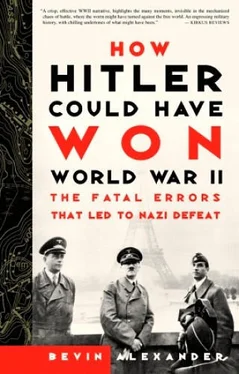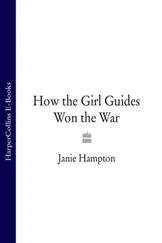p. 149: “the oil fields of the Caucasus with four.” Hitler assembled a million men in fifty-four divisions. In addition there were about 200,000 men in twenty allied divisions (six Hungarian, eight Romanian, and six Italian). The allied divisions were deficient in modern weapons and training. The main striking forces were 1,500 tanks in nine panzer and seven motorized (now designated panzergrenadier) divisions. Also, cannons mounted on tank chassis (self-propelled guns) were coming on line. Unlike previous campaigns, Schnellentruppen— fast troops—were not concentrated, but divided among the five armies (2nd, 6th, 17th, and 1st and 4th Panzer). The panzer armies had three armored and two motorized divisions apiece, but also thirteen infantry divisions between them. All the infantry divisions relied on horse-drawn wagons and the legs of the soldiers. There was thus a marked disparity in mobility between the fast troops and the foot-sloggers. The Soviets assembled about 1.7 million men in 81 rifle divisions, 38 rifle brigades, 12 cavalry divisions, and 62 tank and mechanized brigades in sixteen armies and four fronts. The Soviets had 3,400 tanks, 2,300 of them superior KVs and T-34s. See Tarrant, 30–32; Mellenthin, 144–59.
p. 149: “‘forces at Stalingrad to check it.’” Liddell Hart, The Other Side of the Hill, 214.
pp. 149–150: “‘able to exact a heavy toll.’” Mellenthin, 160.
p. 152: “of the entire city.” On Soviet Lieutenant General V. I. Chuikov and his 62nd Army rested the defense of the city. Chuikov began with eight divisions. To neutralize German air and artillery superiority, he told his men to “hug” the Germans—remain so close that the enemy could not use air strikes or artillery without endangering his own men. The battle was fought out by small groups often separated by a single street or wall. German soldiers were in general better trained than Red soldiers, and by October had split Soviet defenses into four shallow bridgeheads, with front lines only 600 feet from the river front. The Reds resupplied and reinforced their troops at night by boats crossing the Volga. See Glantz and House, 122–23.
p. 153: “‘idiotic chatter’ in his presence.” Goerlitz, 418.
p. 153: “officers of the old German army.” Ibid., 418.
p. 153: “‘through the adjacent fronts.’” Manstein, 302.
p. 154: “either side of Stalingrad.” Stalin had divided his forces into twelve “fronts” under supreme headquarters or Stavka. These fronts usually had about four armies, which directly controlled attached divisions. There was no corps headquarters. What the Russians now called corps were groups of tank and motorized brigades that actually were the size of divisions, controlled by the front commander. Stalin sent a senior general and staff from Stavka to direct several fronts involved in a single operation. The system had the advantage of reducing intermediate headquarters and permitting fast movement of forces in fluid situations. It had the disadvantage of requiring commanders to direct large numbers of units. Stalin returned to army corps in the summer of 1943, before the system had been fully tested. See Liddell Hart, Second World War, 261; Glantz and House, 154.
Chapter 15: Manstein Saves the Army
p. 157: “‘hundreds of miles of front.’” Manstein, 320.
pp. 157–158: “Luftwaffe Field Division arrived too late.” The Luftwaffe Field Divisions were an invention of Hermann Göring, and they were a disaster. Göring formed them because the air force had far too many men for its few aircraft. He persuaded Hitler it was wrong to expose Nazi-indoctrinated air force men to reactionary army generals. He formed twenty-two Luftwaffe divisions, but the men had no training in ground combat, and the officers knew little of tactics or strategy. The divisions could only be used in static roles, and even here suffered extreme casualties and were largely ineffectual. See Goerlitz, 421.
p. 160: “forbidden ‘by order of the Fuehrer.’” Manstein, 334.
p. 162: “‘risks in the military field.’” Ibid., 277.
Chapter 16: The Western Allies Strike
p. 165: “peace feelers in Stockholm.” Dahms, 414.
p. 165: “invasions in the Mediterranean.” FDR sent Marshall and Ernest J. King, U.S. Navy chief, to London July 18–24, 1942, with orders either to convince the British chiefs of staff to accept Sledgehammer or agree that the Americans fight in Africa, while extracting from the British a promise to plan for a cross-Channel invasion in 1943 (Operation Roundup). Roosevelt knew the British would reject Sledgehammer and agree at least to plan Roundup. The real purpose of the conference was to demonstrate to Marshall the true state of affairs. See Liddell Hart, Second World War, 312; Kimball, 152; Bryant, 341–45.
p. 166: “cross-Channel assault might not be necessary.” Kimball, 166.
p. 166: “260 divisions actually in the field.” Das Deutsche Reich und der Zweite Weltkrieg, vol. 6, 713.
p. 167: “same time as Oran and Casablanca.” Churchill, Second World War, Hinge of Fate, 531–38.
p. 169: “French Admiral François Darlan, signed a cease-fire.” The diplomatic jostling leading up to Torch was complicated, but it was only a sideline. The Americans were hoping the French could be convinced to give up without a fight or after token resistance; hence Roosevelt’s insistence on the invasion looking like an American affair. FDR and Churchill refused to use Charles de Gaulle, chief of the Free French, because they didn’t like him for his insistence on French rights at every turn, and because officers in Africa were loyal to Vichy, not him. They settled on General Henri Giraud, an army commander in 1940 who had escaped from a German prisoner-of-war camp. Giraud turned out to have few brains and much conceit, and wanted to be supreme commander of the invasion. Admiral Jean-François Darlan, a notorious collaborator with the Nazis, commander of all French armed forces and presumed heir to Henri Philippe Pétain, leader of Vichy France, happened to be in Algiers visiting a severely sick son when the Allies arrived, and, after tortuous negotiations, became the designated French head of government, while Giraud became commander of armed forces. Darlan called off French resistance but was assassinated December 24 by a disaffected young Frenchman. French forces in North Africa went over to the Allies and formed the nucleus of a large French army, which served with distinction later. But de Gaulle remained the true French leader, as confirmed by his wild reception by the people of Paris on liberation day, August 25, 1944. See Liddell Hart, Second World War, 317–21, 326–32; Kimball, 167–70, 173–75; Bryant, 414, 419, 423–30; Das Deutsche Reich und der Zweite Weltkrieg, vol. 6, 715–17; Blumenson, The Duel for France, 359–66.
p. 170: “arrow on French North Africa.” On August 19, 1942, the British undertook a raid against Dieppe on the French Channel coast with two Canadian brigades, commandos, and tanks (Operation Jubilee). The aim was to test landing tactics and amphibious equipment. The raid was repulsed, with 3,400 casualties among the 6,100 men committed. The Dieppe failure was a propaganda victory for Germany, and it seemed to confirm Hitler’s boasts about the impregnability of the European fortress. The Allies concluded that special assault methods and equipment had to be developed, cooperation between air, sea, and land forces improved, and that major seaports were too well protected to be assaulted. This led to building artificial harbors for the Normandy landings. See Das Deutsche Reich und der Zweite Weltkrieg, vol. 6, 710–11; Zabecki, vol. 2 (Paul Dickson), 1447–49; Dahms, 369–70; Kimball, 163; Robert Sherwood, Roosevelt and Hopkins (New York: Grosset and Dunlap, 1950), 626.
Читать дальше


![Джонатан Димблби - Barbarossa - How Hitler Lost the War [calibre]](/books/385421/dzhonatan-dimblbi-barbarossa-how-hitler-lost-the-w-thumb.webp)









